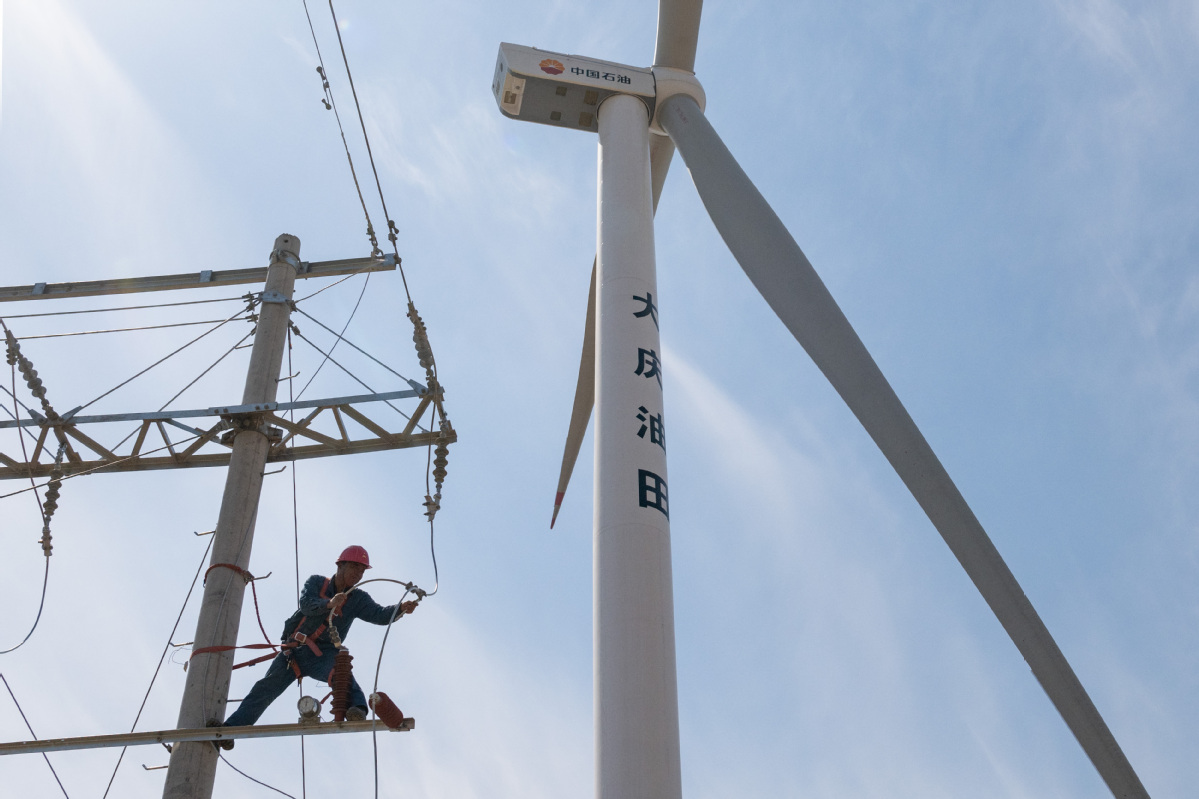China shines in global energy storage

A technician works with power lines at Daqing Oilfield in Heilongjiang province in April. (XIE JIANFEI/XINHUA)
China's energy storage industry has experienced explosive growth in recent years, driven by rapid advancements in technology and increased demand, solidifying its position as a leader in terms of both capacity and innovation, said industry experts.
China now holds a commanding 38 percent share of the global energy storage market, fueled by a surge in new capacity and groundbreaking technological advancements, said the China Energy Storage Alliance.
This growth, driven by China's swift expansion in battery storage and other energy solutions, cements its role as a leader in the sector, said Li Chenfei, senior manager of CNESA.
According to the alliance, China's energy storage sector has seen unprecedented growth, with the operational capacity of new energy storage systems surging to 34.5 gigawatts, marking an annual growth rate of 166 percent year-on-year.
China has added 21.5 GW of storage capacity so far this year, which is three times the amount added during the same period in 2022, accounting for 47 percent of the global increase, it said.
China's momentum in energy storage reflects a blend of strategic policy support, technological innovation, and strong industry partnerships, said Li.
"The government has made clear commitments to renewable energy and carbon neutrality, setting ambitious targets that accelerate demand for advanced storage solutions. These policies are supported by substantial incentives, allowing companies to scale their operations rapidly," he said.
"With established supply chains and a focus on cost-cutting, Chinese companies are able to produce energy storage technologies — especially lithium-ion batteries — at a scale and price point that's tough to match globally."
Advancements in compressed air energy storage have enabled domestic production of essential equipment, bringing system costs down, while other emerging storage technologies remain in the early stages of industrialization and are not yet economically competitive, he said.
Li added that China's dominance in energy storage technology, particularly in battery cell production, places it in a leading position to shape global storage standards.
At the end of the first half, power storage capacity in China surpassed 100 GW, reaching 103.3 GW, a 47 percent year-on-year increase. New energy storage systems now account for nearly 50 percent of the total, with lithium battery storage maintaining a dominant position in this sector, said Li.
According to the New Energy Department of the State Grid Energy Research Institute, while lithium ion batteries are currently dominating, accounting for 98.2 percent of electrochemical storage capacity, China is gradually incorporating various long-duration technologies into its energy landscape.
The country's storage sector is diversifying beyond lithium-dominant technologies, with recent deployments including projects utilizing flywheel and supercapacitor technologies, a compressed-air facility with a capacity of 300 megawatts, and advanced lithium-ion and lead-carbon hybrid setups, it said.
As domestic competition remains intense, profitability in overseas markets is significantly higher, Li said.
The global new energy storage market has also been expanding rapidly in recent years, with a 99.6 percent year-on-year growth and 91.3 GW in cumulative installed capacity in 2023, according to the alliance.
This surge of new energy storage capacity is largely attributable to China's aggressive expansion in renewable energy infrastructure, particularly large-scale wind, and photovoltaic power bases, said Hu Jing, director of the Distributed Energy and Energy Storage Research Office of the State Grid Energy Research Institute, during the recently released Analysis Report on the Development of New Energy Storage 2024.
"China's energy storage sector has entered a phase of scaled growth and routine application in recent years, supported by the steady advancement of new energy and power systems nationwide," said Hu.
"New energy storage solutions are moving toward independent commercialization and market-based deployment, marking a shift from policy-driven models to demand-driven growth. This transition signals a broader integration of energy storage in China's renewable infrastructure, reinforcing its role in stabilizing the power grid and supporting the rapid expansion of renewable energy sources."
Looking forward, industry experts expect China's cumulative new energy storage capacity could reach between 221 GW and 300 GW by 2030, driven by sustained demand for integrated storage solutions and China's expanding renewable energy portfolio.
According to the report, China's energy storage sector has maintained a rapid growth momentum from 2023, with new energy storage capacity expanding from 8.7 million kilowatts in 2022 to 31.39 million kW last year. On the other hand, new energy storage plants in China are increasingly shifting toward centralized, large-scale installations, it said.
Companies have all stepped up efforts in recent years to accelerate their layout of energy storage across the country.
State Grid Corp of China currently has a scale of 36.80 million kW or 77.56 million kilowatt-hours of new energy storage, with 95 percent of this capacity becoming operational over the past three years, underscoring the accelerated pace of energy storage deployment across China.
The utilization rate of new energy storage facilities in the corporation's operational areas continues to rise. In the first half, new energy storage systems achieved an average usage of 459 hours and approximately 109 equivalent charge-discharge cycles, marking increases of about 44 percent and 37 percent, respectively, compared to the same period in 2023, it said.
The role of new energy storage in grid regulation has also strengthened significantly. The maximum short-term peak capacity exceeded 30 million kW, underscoring the importance of new energy storage in ensuring power supply and supporting renewable energy integration.
While China's policy framework for the new energy storage sector is progressively shifting to support large-scale, market-driven growth, Hu suggests further enhancing grid integration and dispatch mechanisms while accelerating the expansion of energy storage.
She also suggested refining market systems to boost efficiency and strengthen safety management alongside innovative pilot programs, so as to foster the high-quality, sustainable development of China's new energy storage industry.
Wang Lining, director of the oil market department under the economics and technology research institute of China National Petroleum Corp, believes the country's vigorously advancing construction of large-scale wind and photovoltaic power bases is expected to drive sustained, large-scale growth in new energy storage, to better enhance the transmission and absorption capacity of renewable energy across regions.
Many of the bases require that storage capacity comprise at least 15 percent of these renewable energy bases — a shift that is accelerating market-driven storage adoption alongside traditional policy incentives.
The outlook for energy storage applications remains broad, bolstered by advancements in battery technology, grid modernization, and supportive government policies, all of which position China as a leader in global storage solutions, said Wang.
China's renewable-rich regions, such as Northwest China's Xinjiang Uygur autonomous region, have spearheaded new installations, with both power and energy storage capacities leading the nation.
To address challenges from large-scale renewable development and the establishment of a new power system, State Grid Xinjiang has been implementing a coordinated "source-grid-load-storage" approach.
The approach includes optimizing both internal and external power distribution and enhancing Xinjiang's power exports while balancing local consumption. By facilitating outbound power transmission and bolstering internal usage, State Grid Xinjiang aims to maximize the utility and efficiency of renewable energy in the region.
In September, State Grid kicked off construction of a new project consisting of power generation facilities in Xinjiang, which has a total planned installed capacity of approximately 19 million kW, comprising 4 million kW of wind power, 8.5 million kW of photovoltaic power, 3.96 million kW of efficient thermal power, and around 2.5 million kW of energy storage.
The project will facilitate the transmission of locally generated electricity to other parts of China, with over 60 percent of the electricity transmitted to Sichuan province and Chongqing to be generated from renewable sources.
Since 2010, State Grid has constructed three power transmission channels in Xinjiang to deliver locally generated electricity to 20 provincial-level regions across the country. The region had transmitted a total of 826.1 billion kWh of locally generated electricity to other parts of the country as of the end of August this year, according to State Grid's Xinjiang branch.
Photos
Related Stories
- Chinese premier urges efforts to facilitate progress of ecological project, energy supply
- 500 megawatt photovoltaic power station under construction in Sichuan
- China urges developed countries to create favorable conditions for international green cooperation
- Opening-up of energy sector to expand further
- China's first dark energy radio detection project certified as SKA Pathfinder, to provide new scientific insights
Copyright © 2024 People's Daily Online. All Rights Reserved.









